'What's It All About, Algae'?
Looking for a quick course on Phycology (algology if you're from
the Old World)? Indonesia's got the goods on all but the
giant kelps. Here's a short picture story on what to
expect:
|
Greens (Division Chlorophyta), what
most folks think of as Algae'¦ Important as foods,
hiding places (you'll be richly rewarded here for looking
closely, then even more closely!). Pictured below: a healthy
bunch of Caulerpa racemosa, C. serrulata, C. webbiana just to
mention three of the same genus found here.
|
More Specifically:
| Caulerpa racemosa, Green Grape
Algae. |
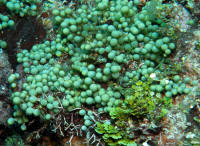
|
| Chlorodesmis fastigiata, Turtle Weed...
common in the wild in reef places, especially where damaged or
polluted. |
|
| Halimeda species are
crusty, calcified algae that look like a bunch of small platelets
strung together in a chain. |
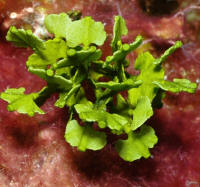
|
|
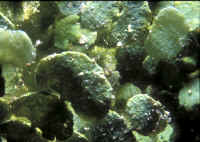
|
Here's a cactus-like articulated algae,
Halimeda discoidea... a favorite haunt of the like-named
Halimeda Ghost Pipefish, Solenostomus armatus (right),
some camouflage job now! |
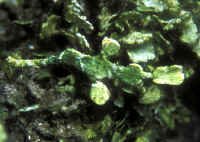
|
| Tydemania
expeditionis Weber-van Bosse 1901, which I like to call
"Dread-Locks Algae", for obvious reasons. |
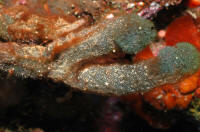 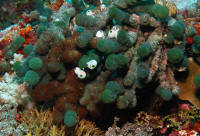
|
| Valonia (Ventricaria)
ventricosa is often noted as the "largest single-celled
alga" reaching a hen's egg in size... but it is actually a
multinucleate vesicle held down by attachment rhizoids.
Dictyosphaeria species, in the same
group, Order Siphonales, are similar with polygonal vesicles,
versus lenticular ones for Valonia. Mithrax/Emerald Green
Crabs may eat these. |
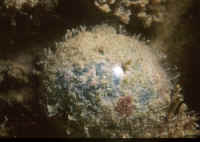
|
Red Algae, the Rhodophyta of Indo.:
| Reds can be leaf-like, filamentous, or encrusting
as hard pieces or flat sheets. Some species are of extreme
importance in reef-building, serving to hold living and non-living
components together in all weather through eons. Shown:
Peyssonniela and Rhodymenia sp. |
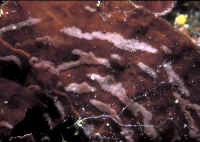
|
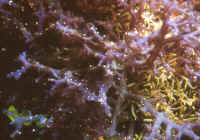
|
| Galaxaura sp. A less than red
admittedly specimen in S. Sulawesi. |
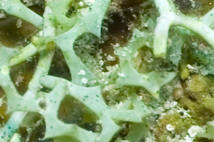
|
| Laurencia sp. Here in S. Sulawesi. |
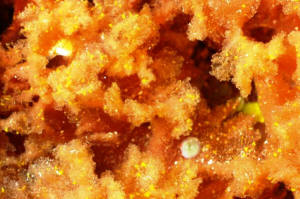 .JPG)
|
Brown Algae, The Phaeophyes:
| Dictyota species, cold to cool to tropical
species (plural). Some examples of colonies, the second
covered in bryozoans. |
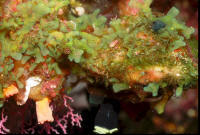 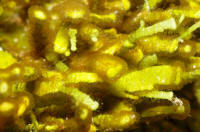
|
|
Lobophora variegata, Encrusting
Fan-Leaf Algae. Fan-shaped blades that encrust rock. Occur in
brown, red, green colors
|
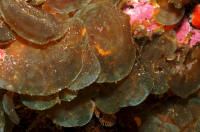 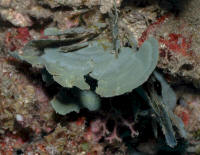
|
Real/Vascular Plants:
| Yes, there are "true"
plants in the sea... most known as "Seagrasses". Unlike
the lowly algae, plants have functional roots, leaves, transporting
tubules (xylem, phloem), flowers (seasonally) and seeds...
Here's a common one for our area, the aptly-named Paddle Weed,
Halophila ovalis. |
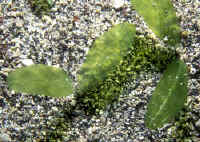 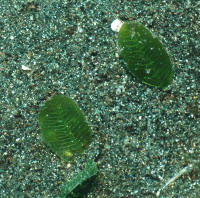
|
| Thalassia hemprichii, Seagrass. Here in S.
Sulawesi on the top of the reef flat and crest. |
.JPG)
|
Oh, and Blue Green "Algae", Actually
Bacteria:
| Usually black to dark blue and always
slimy to the touch, Blue Green Algae, aka Cyanobacteria are sheets,
slimes, threads and more of ancient organisms... Mostly found in
areas that have been heavily damaged... by anchoring, siltation,
chemical pollution. |
|
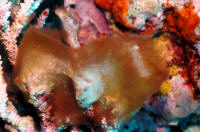
|
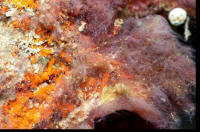
|
Bibliography/Further Reference:
http://www.botany.ubc.ca/people/rob/sulawesi.html
|
|

